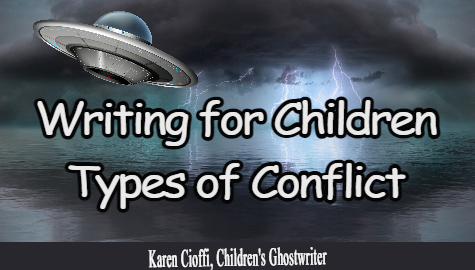There are a number of elements to writing a good fiction story, but one of the most essential ones is conflict. Conflict is what gives the main character (MC) a run for his money. It’s a road block stopping the MC from reaching his goal. And that goal can be anything from getting a new bike to starting a new relationship to staying safe from a tsunami. It’s the conflict that keeps the reader engaged. It keeps her involved, connected to the MC, and turning the pages. Conflict drives the plot forward.
So, what are the two basic types of conflict in children’s writing, and what are some secondary conflicts? To start, think of conflict as having two camps: internal and external.
INTERNAL CONFLICT
According to an article at Bryn Donovan, “Internal conflict has to do with psychological barriers to a decision or a goal. If a struggle takes place in the character’s mind…or heart…then by definition, that’s an internal conflict.”
Internal conflict includes: -Coping with a move to a new school -Coping with a divorce -Coping with an illness -Wanting friends -Battling fear and anxiety -Fighting peer pressure -Struggling with a moral dilemma -Wanting something (a pet, a bike, joining a team)
EXTERNAL CONFLICT
An external conflict comes from an outside force or forces that are beyond the MC’s control. She struggles to overcome the conflict. You might think of Superman and Lex Luther (his nemesis). I know I’m dating myself, but there’s also Sherlock Holmes and Moriarty. Or the movie “Cast Away,” where the MC is stranded on an island. You could also think of the movie “Jaws.” There are three fundamental types of external conflict: nature, antagonist, and society. These three types can include:
-Natural disasters (earthquake, hurricane, tidal wave, tornado, a pandemic) -A bully or enemy (antagonist) -A school or team that lacks inclusion (societal)
Is Your Main Character Limited to Only One Type of Conflict?
While most conflicts will start the story as an internal or external conflict, they often end up having both internal and external conflicts. -Say Christian wants a new bike (internal). He figures out how to get it – the plan is to earn the money doing lawn work. The problem is another boy works the territory and makes it difficult for Christian to make money (external). -Or, maybe Lucas just moved to a new neighborhood and new school. He copes with the move (internal), but a bully makes his life miserable (external). Along with this, the fundamental conflict can cross over to other conflicts. Say there’s a hurricane and Anthony finds a safe place to wait it out only for it to be taken over by someone bigger and stronger. Now you have nature (external) and an antagonist (external) as conflicts.
According to Industrial Scripts, “External conflict feeds into and creates internal conflict within the characters who have to deal with it. Internal and external conflict need each other to survive and it’s in this relationship that drama thrives.” Life is messy, with possible multiple internal and external conflicts in any given scenario. It’s the same with your story’s main character.
Whether you need help with ghostwriting, rewriting, or coaching, let me take a look at your children’s story. Just send me an email at: kcioffiventrice@gmail.com. Please put “Children’s Writing” in the Subject box. Or, give me a call at 347---834---6700. Let’s get your idea off the launch pad or your outline into a publishable and marketable story today! Or, if you'd rather give it a shot and do-it-yourself, check out my book, HOW TO WRITE A CHILDREN'S FICTION BOOK.



2 thoughts on “Writing Conflict in Children’s Stories – Two Basic Types”